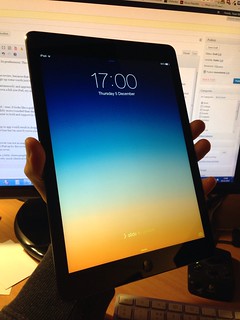23 April 2014. Computer scientists at Carnegie Mellon University in Pittsburgh designed an app for the Apple iPad that allows data stored in worksheets to be manipulated on a touch screen with fingers. Ph.D. candidate Jeffrey Rzeszotarski and computer science professor Niki Kittur will discuss their app, called Kinetica, at next week’s ACM CHI Conference on Human Factors in Computing Systems in Toronto
Kinetica harnesses the iPad’s touch screen to visually sort, order, filter, and categorize cases from data sets to find underlying patterns and trends. With the touch screen, users can gain a visual understanding of relationships in the data, and test various conditions and scenarios by moving data points literally by hand.
The app uses metaphorical tools, such as sieves, which when dragged through a scatter-plot of data points catches cases meeting the pre-defined filter criteria. Likewise, the lens tool also highlights cases in a data set meeting certain criteria, which can then be subject to interactions with other data or variables. A detail view tool, in the form of a magnifying glass, let’s users dig deeper into the properties of individual cases.
Rzeszotarski and Kittur licensed the physics engine — software simulating physical systems and dynamics — Chipmunk Physics by Howling Moon Software that provide a library of routines for handling forces and collisions. As a result objects appearing on the screen can change appearance when interacting with other variables or subjected to other conditions.
The researchers tested a proof-of-concept version of Kinetica with 15 or 16 campus volunteers to compare Kinetica against a standard Excel worksheet in solving tasks and understanding relationships in the data being queried. The volunteers answered specific questions about nutritional value of breakfast cereals and identified cars from a database meeting certain criteria. The volunteers were also given an open-ended task, to find out as much as they could from a database of passengers on the ocean liner Titanic.
The results show participants in the test using Kinetca were able to make the same number of observations and answer specific questions as their counterparts using the worksheet. The Kinetica users, however, were better able to report relationships among variables in the Titantic data set, such as between age and survival, than the worksheet group.
Kinetica users in the test enjoyed the experience, noting the ability to visualize relationships and that they could “play” or “have fun” with the data. Some of the complaints with Kinetica included the inability to display precise values for the data and the lack of an “undo” function.
While the current Kinetica prototype is written for the iPad, Rzeszotarski and Kittur are looking into creating versions for other devices. The following video gives a demonstration of Kinetica.
- Mobile Low-Power Gesture-Recognition System Developed
- Samsung, UCSF to Partner on Mobile Health Care Technologies
- Genome Analysis Via Mobile App, Web Site in Development
- Augmented Reality Applications Enhanced for Mobile Devices
* * *


 RSS - Posts
RSS - Posts